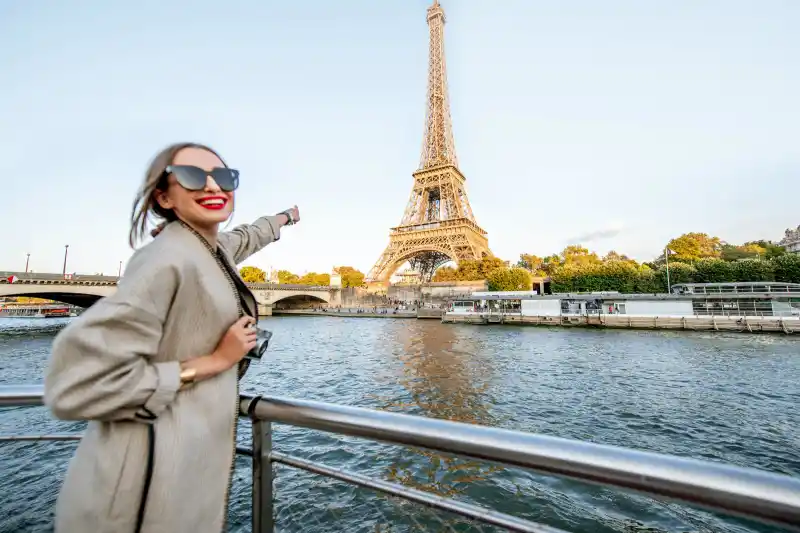
Table of Contents
- Amalfi Coast (Campania)
- Cinque Terre (Liguria)
- Dolomites (Northern Italy)
- Lake Como (Lombardy)
- Lake Garda (Lombardy/Veneto)
- Lake Maggiore (Piedmont/Lombardy)
- Stromboli Volcano (Aeolian Islands)
- Mount Etna (Sicily)
- Sardinia Beaches (Sardinia)
- Gran Paradiso National Park (Aosta Valley)
- This Blog is 10 must-see Natural Wonders of Italy | discover the top picks. if know travel to Italy or other Cities and know anything please visit. Read More

There are places on Earth that make us feel small in front of their beauty. Places that take our breath away and leave us speechless. Italy is one of these lands, a place where nature explodes in all its majesty. From the imposing peaks of the Dolomites to the crystal-clear waters of Sardinia, from the mighty presence of Mount Etna to the enchanted gorges of the Val d’Orcia, every corner of Italy is a treasure to discover and admire.
In this blog, we will venture into the exploration of some of the Natural Wonders that Italy has to offer, traveling through its lands, mountains, rivers, and seas. Get ready to immerse yourself in a world of boundless beauty, on a journey to discover Italy’s unspoiled nature. Here is our personal top 10 list of Italian natural wonders to visit:
Amalfi Coast (Campania)
In southern Italy, you can find a 30-mile stretch of coastline that is home to some of the most stunning landscapes in the entire country. From charming coastal towns like Atrani to the iconic beaches of Positano and the villas of Ravello, here you can get a taste of la dolce vita—the sweet life—on Italy’s most famous coastline. In this blog, I’ll take you with me as I explore this place for the first time, and I’ll tell you everything you need to know to have your own once-in-a-lifetime experience on the Amalfi Coast.
After arriving in Naples by car, we drove south past the historic Mount Vesuvius and Pompeii on our way to Sorrento. We just found the cutest limoncello shop here in Sorrento! We met the owner, Giovanni, and he’s been giving us some amazing samples of his limoncello. The alcohol concentration is pretty high—anywhere from 17% to 37%—so we’re getting the party started early on this Amalfi Coast trip! I highly recommend checking out this shop.
There was a wildfire in a nearby canyon that must have canceled the route, but there wasn’t any clear explanation for why they never came. I don’t think that’s typical for the region—we were just a bit unlucky. Since we got such a late start to the day, we ended up taking our car and parking in Bomerano, which is where the trailhead for this hike is located.
I would say the best route is from Bomerano down to Positano. It’s a very simple hike—very easy—since it’s downhill most of the way and offers panoramic views of the ocean nearly the entire time. However, there aren’t many shady spots, and it can get hot here during the summer. I highly recommend visiting in September, like I am right now, because there are barely any crowds, and it feels like you have the place all to yourself.
There’s no way to sugarcoat it: the Amalfi Coast may be beautiful, but it’s also one of the most expensive summer destinations in Europe. Main dishes at restaurants usually cost between 15 to 25 euros at a minimum, and a glass of wine will typically cost between 6 and 9 euros on average. Hotels start at around 150 euros per night, but the prices for luxury accommodations here can skyrocket.
The high season runs from June to August, but I recommend visiting in May or September to save on peak-season prices and avoid most of the tourists.
Cinque Terre (Liguria)
On the rugged Italian Riviera, Cinque Terre comprises five picturesque villages: Monterosso al Mare, Vernazza, Corniglia, Manarola, and Riomaggiore. These villages are extremely well-known for their stunning scenery, colorful buildings, and sensational panoramic sightings. This is a UNESCO World Heritage site, with cliffs, terraced vineyards, and an energetic sea that draws in the traveler in search of nature and a glimpse of classic Italian life.
Monterosso al Mare is the largest village with beautiful sandy beaches and the medieval Church of San Giovanni Battista. Vernazza is considered to be the most beautiful of them, having a charming harbor and an old Castello Doria. Corniglia sits on a hilltop, boasting breathtaking views of the surrounding areas. It is much quieter and less touristy than the other towns. Colorful Manarola clings to the cliffs and boasts the most spectacular sunset in town. Riomaggiore, the southernmost village, has a quaint marina and offers easy access to scenic hiking trails.
Cinque Terre is not just about beautiful landscapes; it has an equally interesting history and culture. The region is renowned for its traditional Mediterranean cuisine, of which seafood and pesto are the local favorites. Well-preserved agricultural terraces have been used in this region for centuries to grow grapes, olives, and lemons.
Hiking enthusiasts will love the scenic trails connecting the villages, which sometimes end up with breathtaking views of the Ligurian Sea. Whether you are taking in colorful streets, free time by the sea, or hiking between the villages, Cinque Terre is a timeless example of beauty and tranquility on the Italian coast.
Dolomites (Northern Italy)

The Dolomites are a mountain range in northern Italy and includes part of the Southern Alps. The Dolomites are one of the most beautiful places in the world, with plenty of nature, trekking, rock climbing, and skiing opportunities. Characterized by dramatic peaks and striking landscapes, they extend over three regions: Trentino-Alto Adige, Veneto, and Friuli Venezia Giulia.
Known for its strange geology, towering peaks of limestones and their sheer cliffs form an outstanding contrast with the lush valleys that lie below them. During dawn and afternoon, it becomes all the more breathtaking as the peaks attain shades of pink and orange colors that turn this area into a fantasy realm.
The Dolomites all year round are a dreamland of outdoor sports: in winter, the top skiing area with world-class resorts attracting visitors from all over the world, including Cortina d’Ampezzo and Val Gardena. During summer, the mountains become a place for hiking, mountaineering, and cycling on its many trails, winding through alpine meadows, crystal-clear lakes, and ancient forests.
Rich in culture and history, the area is varied in architecture, food, and tradition by the mix of Italian, Ladin, and German influences. The local villages, such as Ortisei and Canazei, can be very charming. Visitors can try typical Tyrolean dishes such as speck, a type of smoked ham, canederli (dumplings), and apple strudel.
From the stunning peaks and overviews to taking in the culture and outdoor adventure, the Dolomites offer something special that is hardly matched.
Lake Como (Lombardy)
Lake Como is situated in the province of Como in Lombardy, Northern Italy. It is part of the Italian Lake District. Popular with visitors for well over 100 years due to its combination of fresh air, water, mountains, and good weather, it’s still worth a visit. The lake is shaped rather like an inverted ‘Y’, with two ‘legs’ starting at Como in the southwest and Lecco in the southeast, which join together halfway up, and the lake continues up to Colico in the north. The first few kilometers of the ‘legs’ at the southern end of the lake are relatively flat, but Lake Como becomes more mountainous as you head north into the Alps. Some of the nearby peaks rise slightly above the tree line, so the views are truly impressive. In the winter, there is skiing in the nearby valleys.
The area around Lake Como, or “Lago di Como” in Italian, is quite characteristic. It has a unique flair and sense of history that tends to impress visitors on a deeper level, beyond just the touristic perspective. It has been appreciated for its beauty and uniqueness for ages, even as early as Roman times. Its atmosphere and natural surroundings have inspired a significant part of the creation of Naboo in the Star Wars movies.
Lake Como has been a popular retreat for aristocrats and wealthy individuals since Roman times and is a very popular tourist destination with many artistic and cultural gems. It is home to many villas and palaces. Many famous people have or have had, homes on the shores of Lake Como, such as Madonna, George Clooney, Ronaldinho, and Sylvester Stallone.
Lake Como is widely regarded as one of the most beautiful lakes in Europe.
Lake Garda (Lombardy/Veneto)
The largest lake in Italy, Lake Garda, is situated in the regions of Lombardy, Veneto, and Trentino-Alto Adige. This beautiful lake lies between the Alps in the north and the soft hills of the south. It is renowned for its crystal-clear waters, quaint lakeside towns, and a Mediterranean-like climate. A place where nature and history come together, offering unforgettable moments all year round.
Around the lake are scattered quaint villages, lively cities, and lush landscapes. The most popular towns include Sirmione, Desenzano del Garda, and Riva del Garda, each carrying a different atmosphere. Sirmione, situated on a narrow peninsula, is home to the medieval castle Scaligero Castle and the remains of the ancient Roman Grotte di Catullo. Desenzano del Garda is full of life, has a beautiful promenade, and offers great nightlife, while Riva del Garda is a favorite for sports lovers with hiking, windsurfing, and mountain biking.
The southern shores of Lake Garda are far more laid-back, Mediterranean style, with palm trees, olive groves, and vineyards. The northern shore is quite dramatic with steep cliffs and mountainous terrain, perfect for adventurous travelers. Malcesine offers a charming historic center with a cable car to the top of Monte Baldo, affording breathtaking views of the whole lake.
In addition to its natural beauty, Lake Garda boasts a rich cultural heritage, with ancient castles, churches, and museums scattered around the shoreline. The area is also famous for its local cuisine, including olive oil, wine, and fresh fish from the lake.
Whether you’re exploring its charming villages, enjoying water sports, or simply relaxing by the shore, Lake Garda offers a perfect blend of adventure, relaxation, and culture.
Lake Maggiore (Piedmont/Lombardy)
Lake Maggiore is one of the most enchanting and serene lakes in Italy, nestled between Piedmont and Lombardy. Famous for its beautiful scenery, mild climate, and historic appeal, Lake Maggiore is the second-biggest lake in Italy, offering ideal harmony between natural beauty and cultural heritage. The lake extends from the southern Alps to the plains of Lombardy and offers a remarkable view of snow-capped peaks, lush greenery, and picture-postcard towns along its shores.
It is renowned for its lovely lake-side villages and islands. The town on the west shore, named Stresa, is the most famous and was noted for its handsome lakeside promenade and villas, beautiful with parks on slopes, being quite close to the Borromean Islands, including Isola Bella, Isola Madre, and Isola dei Pescatori, each worth seeing. Isola Bella boasts the magnificent Borromeo Palace and its beautiful terraced gardens, while Isola Madre is known for its lush botanical gardens and exotic plants. The most traditional is Isola dei Pescatori, with its quaint fishing villages and peaceful, rustic charm.
Besides Stresa, other towns like Arona, Baveno, and Verbania are each charming in their own way. Arona has the gigantic statue of San Carlo Borromeo, while the green estates of gardens make Verbania an ideal base for exploration on the northern part of the lake.
Lake Maggiore is also a center of outdoor sports: its waters are perfect for sailing, boating, and kayaking, while hiking and cycling routes snake through the hills and surrounding mountains. The nearby Val Grande National Park offers rugged landscapes for trekkers and lovers of nature.
This region also boasts a rich cultural heritage, with historical sites like ancient castles, churches, and villas. The local cuisine is characterized by fresh fish from the lake, cheeses, and fine wines, especially coming from the nearby Gattinara wine region.
Stromboli Volcano (Aeolian Islands)
Stromboli, the lighthouse of the Mediterranean, is an active volcano that rises to 925 meters above sea level. This blog is about docking options around Stromboli Island. There’s Carly, which is the main hub. You can anchor or pick up a mooring on the east side of Punta de la Luna between April and October. North of the main area, there are buoys and boat services to go ashore. In calm weather, you can anchor off the black beach in front of the village on the south side, under the Galena. Keep clear of underwater cables, which are marked on the charts.
You can anchor off the south of the ferry pier, where the depth drops quickly from 10 to 20 meters, and the holding is uncertain in the wind from any direction. At Chico Grande, you can anchor in 10 meters depth. The bottom is rocky. At Action Ostra, you can anchor off either side of Impalas. After dark, it’s good to motor around to the northwest or the west side, where you have a great view of Stromboli’s fireworks. One mile north-northeast of the anchorage lies Stromboli Geo. Even in calm weather, you can’t anchor here.
Mount Etna (Sicily)
Mount Etna, located on the eastern coast of Sicily, Italy, is one of the most famous and active volcanoes in the world. It is not only Europe’s largest and most active volcano but also a captivating natural wonder that attracts visitors from around the globe. With its frequent eruptions, it stands as a prominent feature of the landscape, shaping the culture, history, and natural beauty of Sicily.
Standing at approximately 3,330 meters (10,922 feet), Mount Etna is a towering presence that can be seen from miles around. Its eruptions, which occur regularly, range from gentle lava flows to more explosive events. These eruptions create dramatic landscapes, from blackened lava fields to fertile, lush slopes. The volcano is surrounded by a variety of ecosystems, including vineyards, orchards, and ancient forests, due to the nutrient-rich soils created by past eruptions.
The mountain offers multiple ways to experience its awe-inspiring beauty. Visitors can take a cable car or off-road vehicles to reach higher elevations, where they can hike around the craters, witness volcanic activity up close, and enjoy panoramic views of the island and the Mediterranean Sea. The Rifugio Sapienza area serves as a base for those looking to explore the volcano further, offering both summer and winter activities. In winter, the upper slopes of Etna become a skiing destination, adding an exciting contrast to the summer hiking season.
Around the volcano, charming Sicilian towns like Catania, Zafferana Etnea, and Nicolosi provide the opportunity to experience local culture, food, and traditions. Catania, located at the base of the mountain, is particularly famous for its baroque architecture and lively atmosphere, while Zafferana Etnea offers a more relaxed, rural environment, with local food markets and stunning views of the volcano.
Mount Etna’s unique combination of natural beauty, cultural significance, and thrilling volcanic activity makes it a must-see destination for anyone visiting Sicily. Whether you’re interested in geology, hiking, skiing, or simply soaking in the views, Etna provides a memorable experience.
Sardinia Beaches (Sardinia)
Today, we will talk about the top 10 beaches that one should not miss if he or she is in Sardinia. Get ready for an important journey to paradise as we take you through the most catching coastal beauties of this Italian island.
Number 10: Tinari Beach. Situated along the north coast, Tinari Beach is such a beautiful place with cliffs, white pristine sand, and a peaceful ambiance to chill and connect with nature.
Number 9: Isola Piano. Isola Piano boasts soft sandy shores and cool waters. It’s uninhabited, thus guaranteeing a tranquil and untouched getaway.
Number 8: Torre di Capo Malfatano. This beach is located on the southwestern tip and features one of the many ancient watchtowers from the 16th century. The golden sands and clear waters make it a gem for beachgoers and history enthusiasts.
Number 7: Rena di Ponente. This is on the east and is actually two divided by a small road; it is to be included in any Sardinia road trip.
Number 6: Spiaggia della Torre Vignola: This beach, in the Gulf of Asinara, has charming towers and shallow waters, making it perfect for families. The color of the sea is cyan in this place.
No. 5: Spiaggia di Cala Licosi: Sheltered within a nature reserve, this beach boasts original rock formations with crystal-clear waters. For snorkeling and underwater explorations, this is a paradise.
Number 4: Spiaggia di Li Baietti. A rocky beach with natural pools. Architects integrated a wooden construction into the stones, creating a platform everybody is free to use to sit down and relax for free.
Number 3: Spiaggia La Pelosa. On the northwest coast, this famous beach is stunningly beautiful, with soft white sand, bright turquoise crystal-clear waters, and views of Isola Piana. It is just a must-go destination.
Number 2: S’Archittu. The latter one is located on the western coast and features an exceptional natural arch, made up of stretches of sandy area with rocky coast inlays, perfect for both sunbathing and sightseeing.
And finally, at Number 1: Nestled between tall cliffs, this UNESCO World Heritage Site beach on the east coast features crystal-clear water, unique rock formations, and postcard-beautiful scenery.
Just pack your bags and arrange for the next beach tour to this island heaven.
Gran Paradiso National Park (Aosta Valley)

The most beautiful towns in the Aosta Valley, in ranking order, are listed below.
10th place: La Salle. Almost entirely renovated, the village kept respect for the original architecture of pre-existing houses.
9th place: Vèrres. This enchanting village lies nestled in the mountains and is surrounded by the most unspoiled nature of the province of Aosta.
8th place: Fènis. In Fènis, there is one of the most beautiful medieval castles in Italy, which is definitely worth a visit.
7th place: Arnad. In the village, you can take excursions of varying lengths, but the sport for which this municipality is particularly suited is climbing.
6th place: Gressan. On the first Sunday of October, an event takes place that celebrates the apple harvest.
5th place: Antagnod. Known especially for its ski slopes, Antagnod is a village where you can practice many activities in nature.
4th place: Avise. This location has always had significant strategic importance, still testified by its three castles.
3rd place: Bard. Its architecture blends perfectly with the surrounding nature and the rocky spurs of the high hills that surround it.
2nd place goes to Saint Pierre: if anything, the castle dominates the top of the scene, making it even more fairy-tale-like.
1st place: Etroubles. It lies at an altitude of 1,270 meters above sea level in the splendid alpine context of the Gran San Bernardo Valley.
In conclusion, these are just some of the many natural wonders that Italy has to offer. Each region, province, and landscape has its uniqueness and beauty. From the beaches in the south to the mountains in the north, from the islands off the coast to the vast plains, Italy is a country that offers endless possibilities to discover the beauty of nature.
And remember, the adventure never ends! There are still many more destinations and examples to explore and discover, in a continuous journey to uncover the beauty of our land.
Thank you, and that wraps up our 10 must-see Natural Wonders of Italy | Discover the top picks. Do you agree with the places we chose, or is there somewhere you visited that you feel should be on the list? leave us a comment.






